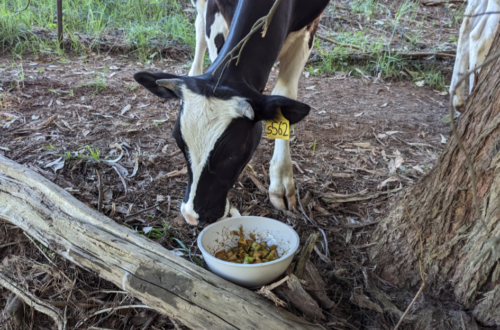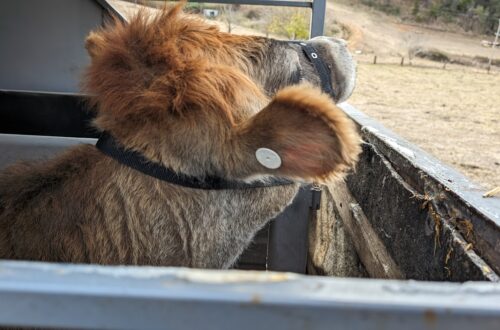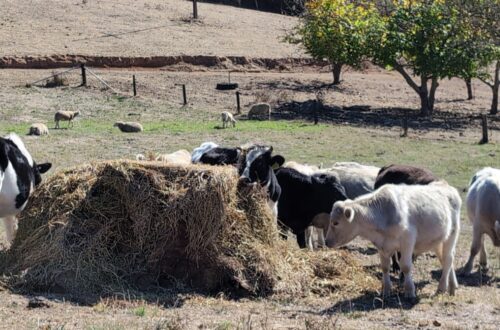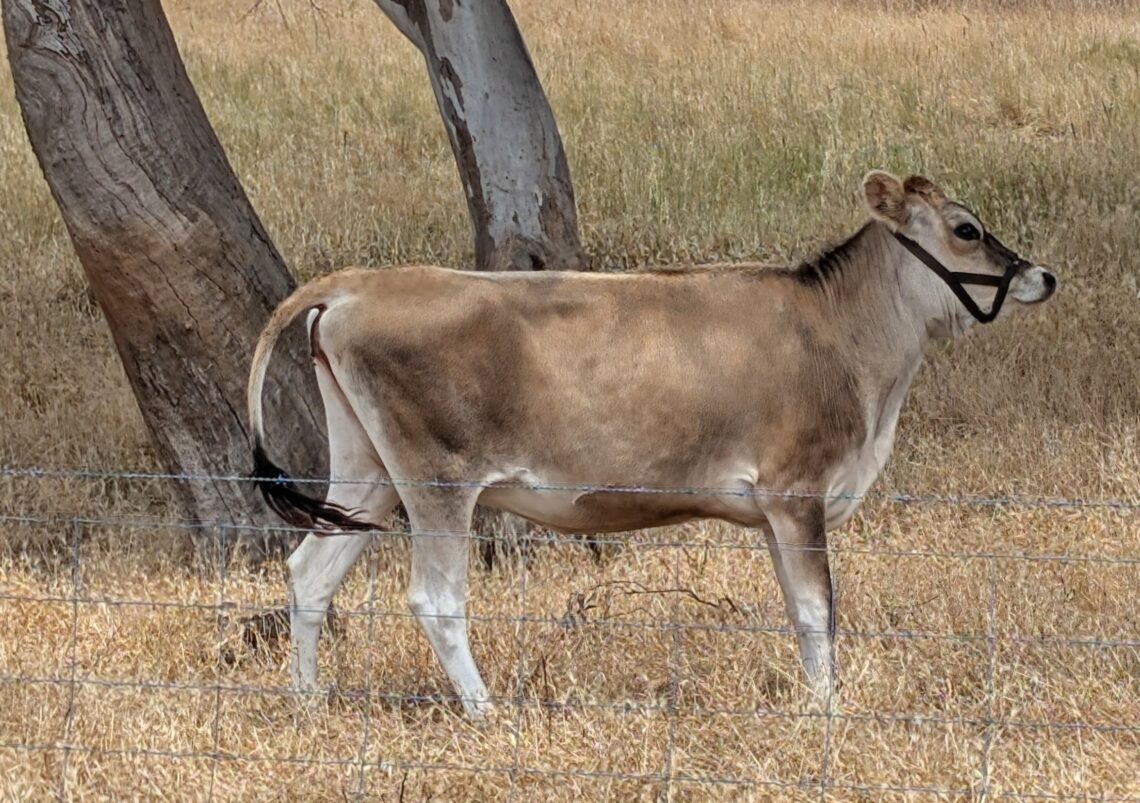
House cow part 2
With very little experience we bought Honey the house cow home, see here for part 1.
With everything we’ve had going on lately, I haven’t had the chance to share any updates on Honey’s progress. Between the projects and day-to-day tasks on the farm, time has flown by. I’m excited to finally take a moment to reflect on how far we’ve come with the house cow training. It’s been a journey to help Honey feel comfortable and at ease with us. I’d love to share the steps we took to build her trust and create a bond. Here’s a glimpse into how we’ve been working with her and the progress she’s made.
May
Once Honey had some time to settle in, I started heading down to the paddocks to interact with the Holstein steers. This gave her the opportunity to approach the fence on her own terms. After a few days, she worked up the courage to sniff at the molasses I offered her. However she remained cautious and hesitant about letting me pat her.
Building Honey’s confidence and trust required a lot of patience. To help her feel more comfortable and start improving her condition, I bought a grain and chaff mix with molasses, typically used as horse feed. I began by offering her a couple of handfuls a few times a day. Honey was quite underweight when she arrived, and the pasture was struggling after a dry autumn. I wasn’t too worried about overfeeding her at this stage.”
My goal was to get Honey comfortable enough to let me pat her while she ate. At first, she would startle and back away whenever I reached out, so it took some time and patience. After about a week, she remained still long enough for me to touch her poll, the area between her ears. I quickly discovered that she enjoyed light finger scratches just behind her poll.
June
Once she stopped flinching as I touched her poll, I adjusted the feeding routine. I positioned the bucket so that her side was aligned along the fence, allowing me to gradually work on touching her ears and neck. I focused on areas where she seemed least reactive, slowly expanding to other parts of her body. This was a lengthy process, and since I stayed on the other side of the fence throughout, I could only reach so much of her.
The reason I avoided entering the paddock was to encourage her to approach me willingly. I didn’t want her to feel pressured or develop the habit of running away whenever I came near. Once she became comfortable with being patted without flinching, I started delaying her access to treats. This helped build trust and reinforce our bond.
At first, it felt like a significant step backward—it became a battle of wills. She wanted the bucket, and I wanted her to accept being patted. But once she realized that making contact on my terms led to a reward, she learned quickly and started cooperating more willingly.
July
By July, I had gotten Honey comfortable enough to allow me to pat her for several minutes without needing to give her a reward. The next step was to remove the bucket of feed from the equation. I started by eliminating the bucket during my morning visits while still giving her lunch and a late afternoon treat. I continued this routine for about two weeks.
A key part of the training was hiding the bucket behind my back early on so she wouldn’t avoid me if she didn’t see it. Instead, she learned to connect my voice with the food. This became clear when she began running to the fence, bellowing in excitement, as soon as she heard me talking near the house.
After the initial fortnight, I started occasionally skipping the lunch treat. Within a week, I fully removed it from her routine. By the following week, she was down to only receiving a late afternoon treat now and then. This gradual approach helped her shift her focus from the food to the interaction itself. Building trust and reinforcing our bond.
Throughout this entire process, we always ensured Honey had access to a bale of hay, as this season had been particularly challenging.
August
It took about two and a half months for Honey to transition from being scared to eagerly running up to the fence for pats instead of treats. By August, we began entering the paddock with her. While we still used treats, they were given sparingly and without a predictable pattern. Only giving honey treats when we entered the paddock.
After a week of Lanky and me visiting her in the paddock, we started bringing the kids along. These supervised visits were an opportunity to teach them how to interact with Honey safely and respectfully. A week later, I allowed the teenager to go in unsupervised, which led to the most significant progress. Within a week, the two had become inseparable. The teenager would sit in the paddock, either reading a book while Honey stayed close by enjoying pats or filming videos of their interactions.
By the end of August, we had stopped bringing the treat bucket into the paddock entirely. I also began working on desensitizing her to touch on her legs, underside, and udder. Hopefully helping her grow more comfortable with close engagement for when she is a lactating house cow.
October
In early October, my niece and nephew came to visit, giving Miss Honey plenty of opportunities for extra socialization. Being school holidays, she was absolutely spoiled with attention nearly all day, every day. After they returned home, we began rounding up the cattle in preparation for moving the herd as we prepared to vacate the rental property.
Before the big move, we decided to see how Honey and the Holstein steers would handle being in the same paddock, hoping she’d have some company while we waited to relocate. Unfortunately, Honey and the Holsteins didn’t take kindly to sharing their space. By the end of October, we transported all the steers to the other property, where they were temporarily housed with the Angus heifers.
Honey, who had been quite stressed during her last experience being floated (transported in a horse trailer), was moved to her own private paddock at the front of the new property. This time, she handled the transport so much better—no signs of stress, no drooling, and no whites of her eyes showing when we unloaded her.
Although we aimed to visit her several times a week, a family emergency arose at the end of October. This resulted in me staying in New South Wales for most of November, leaving less time to spend with her.
November
During my absence, Lanky and our teenager made a point to visit Honey for about 30 minutes a few times each week.
When I returned to the state at the end of November, I wasted no time and headed out to see Honey. At first, Honey seemed a bit sulky, perhaps upset that I hadn’t been there to visit. However, after about an hour, she forgave me and happily let me stand there, patting her and checking her over.
House Cow Notes
We planned to breed Honey using either artificial insemination or introducing a bull to her, aiming for attempts between November and January. However, we postponed purchasing a cattle yard, vet crush, and loading ramp. The ramp is essential for loading and unloading at the bull studs in our area. while the vet crush is necessary for artificial insemination, as it provides a safe way for the vet to perform the procedure.
We also haven’t lead trained her yet.
Lead training your dairy cow is beneficial for several reasons.
- Safety. A lead-trained house cow is easier to handle, reducing the risk of accidents for both you and the animal.
- Ease of Handling. Lead training makes it simpler to move Honey between pastures, into the milking parlor, or during veterinary visits. This can save time and effort.
- Improved Veterinary Care. A lead-trained cow is easier to manage during health checks or medical procedures. It allows the veterinarian to work with Honey more efficiently, which can lead to better overall health outcomes.
- Better Behavior. Training helps establish a bond and improves Honey’s behavior around people. A well-trained cow is often more relaxed and easier to manage in social settings.
- Easier Milking. lead training can help Honey become accustomed to the milking process, making it more efficient and less stressful for both of you.
Over the past 6 months I haven’t attempted to lead train Honey. We focused on building a lot of trust and getting her comfortable with our interactions as she was a very nervous heifer. she has been lead a couple of times when we have had to move her from paddock A-B and when we loaded her up to take her to the new property. she required someone pushing from behind and someone pulling from the front.
We aim to spend the next 4-5 Months lead training her and also getting her used to being put in a stanchion. the one thing I’ve learned from others is when Honey does calf her hormones might make her a little unpredictable.
Our plans moving forward.
So once all that training is completed we hope to AI honey in May-June 2025 so she can calve in March 2026.
Honey is proving herself to have great potential as a house cow, hopefully in March 2026 we will have some rewards from our training.
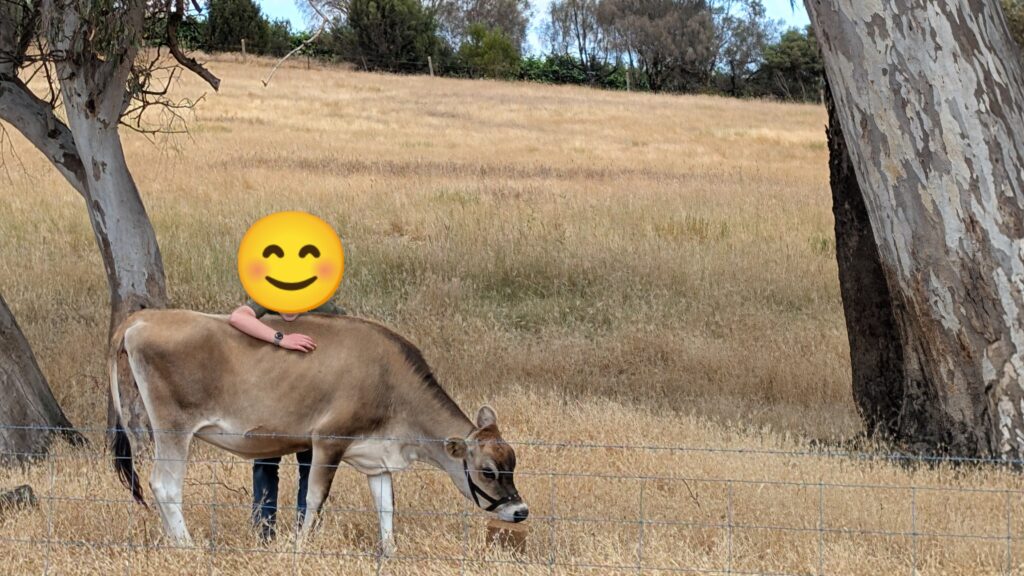
Head here to see honey demanding head scratches.

